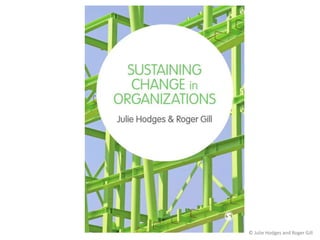More Related Content
Similar to Chapter 13 ensuring sustainable change and transformation through monitoring and measurement (20)
More from BHUOnlineDepartment (20)
Chapter 13 ensuring sustainable change and transformation through monitoring and measurement
- 3. Learning outcomes
• To identify the factors that contribute to measuring and monitoring
organizational change and transformation
• To apply techniques for sustaining change
• To describe the pitfalls that can be encountered when seeking to
sustain change
• To identify the benefits and risks of change
• To measure the impact of change
© Julie Hodges and Roger Gill
- 4. Measuring the impact of change
• Establish a clear aim
• Define the key measures
• Collect baseline data
• Collect data consistently
• Chart progress
• Ask questions
© Julie Hodges and Roger Gill
- 5. Balanced Scorecard objectives, measures, targets and initiatives
(Adapted from Kaplan and Norton (1996) ‘The Balanced Scorecard’, Harvard Business Review, January/February, p.76)
© Julie Hodges and Roger Gill
- 7. Reasons for identifying benefits
at the start of the process
• Benefits are identified, measured and the process is locked in from the start.
• The business case for change is identified in a quantifiable way.
• The reason for change is clear; the benefits provide a focus for everyone.
• Return on investment in change can be measured.
• Success can be identified, recognized and celebrated, thereby having a positive
impact on future change initiatives.
• There is clear agreed accountability for sustaining change.
• Progress can be tracked, monitored, and delivered.
• Stakeholders are clear about both current and expected performance.
• The credibility of the change is enhanced through realization and recognition of
the benefits.
• The cost of implementation is calculated, understood and monitored.
© Julie Hodges and Roger Gill
- 8. Realizing benefits
• Engaging stakeholders
• Developing the business case
• Identifying risks
• Developing a tracking mechanism
• Tracking benefits
• Communicating achievement of benefits
• Monitoring and reviewing benefits realization
© Julie Hodges and Roger Gill
- 9. Reasons for managing risks
• To reduce or eliminate where possible the impact of a risk that has
occurred.
• To increase the chance of success of change(s).
• To reduce or eliminate where possible the probability of a risk
occurring.
• To reduce or eliminate where possible the financial impact of a risk that
has occurred.
• To Increase the visibility of risks to management and other staff.
• To secure successful continuity and profitability.
• To secure a stable working-environment for staff.
© Julie Hodges and Roger Gill
- 11. Identifying risks
• External risks
- External risks are outside the control of managers. Egs include government regulatory
changes, new products and services from competitors, A&Ms, disasters such as floods,
earthquakes.
• Cost risks
- Risks which are directly or indirectly under control of manager. Egs cost overuns by
project teams; scope creep, poor estimating or errors that result in unforseen costs,
overruns on budgets and schedules
• Technology risks
- result from a wide variety of circumstances. Typical examples are problems with
immature technology, use of the wrong tools, software that is untested or fails to work
properly, requirement changes with no change management, failure to understand or
account for product complexity, integration problems, and software/hardware
performance issues (poor response times, bugs and errors.).
• Operational risks
- Operational risks can result in a failure to realize the intended or expected benefits of
the project. Typical causes are inadequate resolution of priorities or conflicts, failure to
designate authority to key people, insufficient communication or lack of a communication
plan, and rollout and implementation risks – ‘too much, too soon’.
© Julie Hodges and Roger Gill
- 12. Mitigating risks
• Avoid.
- Counter-measures are put into place that either stop the threat or problem from
occurring or prevent it from having any impact upon the change.
• Transfer.
- A specialist form of risk reduction, where the impact of the risk is passed on to a third
party via, for instance, an insurance policy or penalty clause, albeit at a cost.
• Mitigate.
- Where the response actions either reduce the likelihood of the risk developing or, if the
risk occurs, limit the impact on the change to acceptable levels.
• Accept.
- There is acceptance of the possibility that the risk might occur.
© Julie Hodges and Roger Gill
- 13. Approaches for monitoring change
• Feedback
• Survey
• Review the implementation plan
• Review the communications
• Monitor how people are
responding emotionally
• Performance management
© Julie Hodges and Roger Gill
- 14. Factors for sustaining change in
organizations
• Be aware of the drivers for change
• Diagnose the need and readiness for
change
• Plan and implement change
• Identify and implement relevant
interventions
• Communicate
• Identify and manage the impact of change
on people
• Monitor and measure
• Manage and lead change …
© Julie Hodges and Roger Gill
- 15. Summary
• Measuring and monitoring change is a key element to successfully
sustaining change.
• Benefits should be identified at the start of a change process and
monitored throughout in order to ensure they are realized.
• Risks need to be identified, mitigated and reviewed throughout a change
process.
© Julie Hodges and Roger Gill
